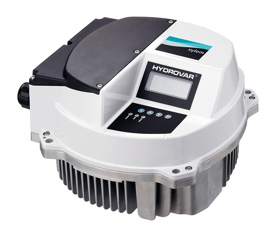A variable approach to efficiency

With further legislation on energy efficiency heading towards us in 2018, Mark Bradley considers the options, and highlights one simple technology that offers a number of benefits for designers and clients alike.
The phrase “government introduces new legislation” can strike fear into the hearts of even the most stoic of landlords. It’s understandable, then, that the new Minimum Energy Efficiency Standards (MEES), which were designed to provide a clear and consistent message on minimum standards for non-domestic buildings, have got many landlords talking.
Recently, non-domestic buildings have come under particular scrutiny as being responsible for 12 per cent of the UK’s emissions. To give this some context, transport as a whole was responsible for 24 per cent, according to a 2015 report by the Department for Business, Energy and Industrial Strategy (BEIS).
 |
| Variable speed drives offer a simple but very effective solution to boost energy efficiency. |
A disproportionate number of these buildings are also holding inadequate ratings for their energy performance, with around one in five currently operating with an Energy Performance Certificate (EPC) of F or G. This is largely due to ageing buildings using inefficient or inadequate heating and water systems. Under the MEES, all non-domestic buildings will require a minimum EPC rating of E if they are to be let.
Each building is judged on its own merits, but for systems under 25 years old, improving an EPC rating could be as simple as retrofitting existing systems with efficiency-enhancing technology, such as variable speed drives (VSDs). For systems older than 25 years, it is often recommended that landlords replace ageing or inadequate features, which may not reap the full benefits of retrofitted technologies. By conducting an energy audit before committing to an EPC assessment, you can target the areas of your systems that need replacing or enhancing, which may allow you to meet, or even exceed, an E rating for your building.
One of the simplest ways to help improve the efficiency of your building is to retrofit the existing system with variable speed drives. Most water and heating systems currently have traditional booster sets, which use fixed speed technology. This means that, even when the demand for water is low, the system runs at one consistent level of energy whenever it is used.
This is extremely inefficient and wasteful, and is particularly problematic for large non-domestic buildings, where, for example, one person using the shower on the fourth floor in a building with no variable speed drive will use as much energy as ten people on each floor where a variable speed drive has been fitted.
Replacing a conventional fixed speed unit with a variable speed booster set can help, with the potential to generate energy savings of up to 50%. This is because, as the name suggests, they vary the flow and power of the water depending on where it is being used, and by how many people. Variable speed drives for your heating and water systems are also easy and quick to install, and can often be retrofitted to existing systems – in many cases there are ‘plug-and-play’ options available, meaning you simply attach them to the top of a pump. With a payback period of less than two years, Xylem’s variable speed drive, the Hydrovar, is an example of a simple and cost-effective way of hitting the targets for MEES, while also keeping bills down.
 |
|
Moving water around a building is a significant energy-user. Use of energy efficient technologies cuts waste, and boosts comfort for occupants. |
MEES are certainly a step in the right direction, as it’s important that landlords strive to improve the efficiency of their buildings. After all, a more efficient heating and water system would mean significant cost savings for both landlords and tenants. However, there’s a lot to take into consideration here, and the penalties for non-compliance, barring any exemptions, can be severe. One of the best ways to ensure buildings are compliant to the new standards is to partner with an expert in heating and water systems. This will not only improve your infrastructure in a cost-effective way, but will also leave you feeling confident that this piece of government legislation will benefit both you and your tenants in the long-term.
Mark Bradley is northern regional manager for Building Services and Industry at Xylem UK.







